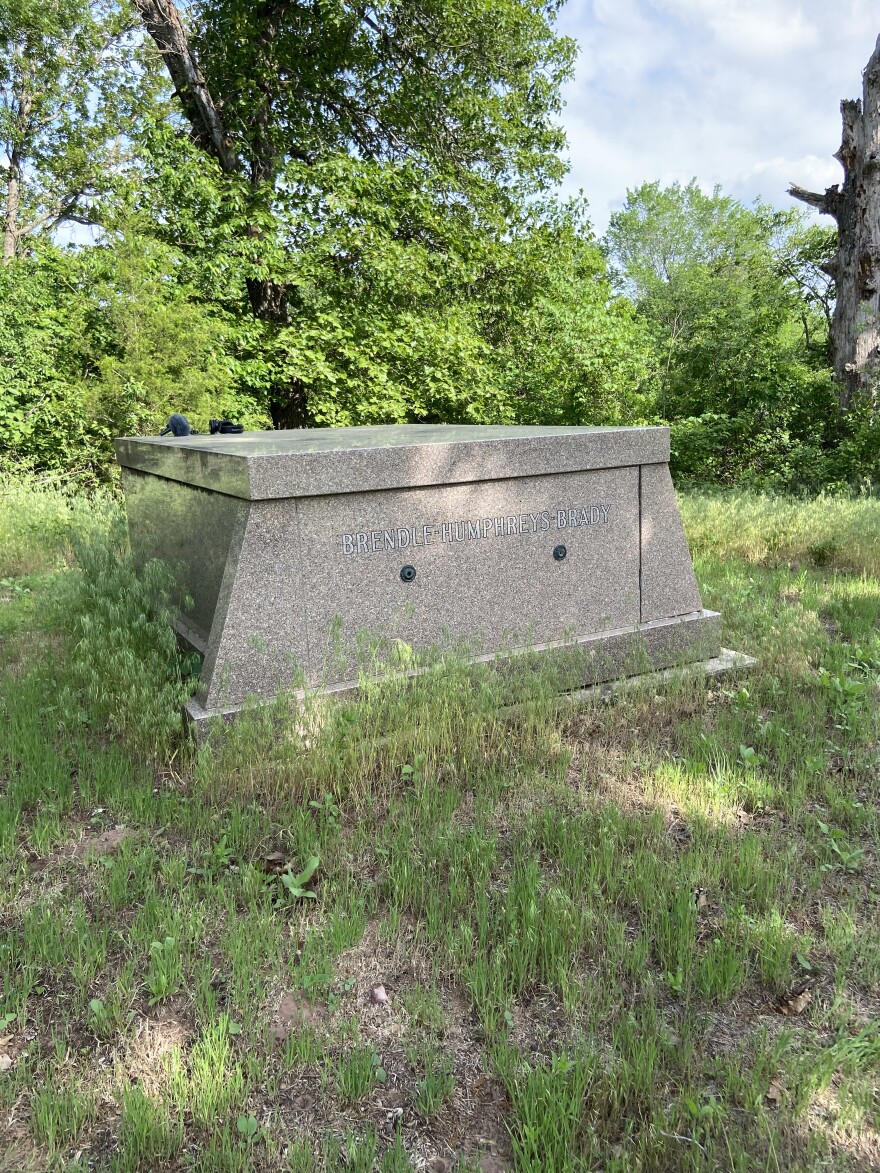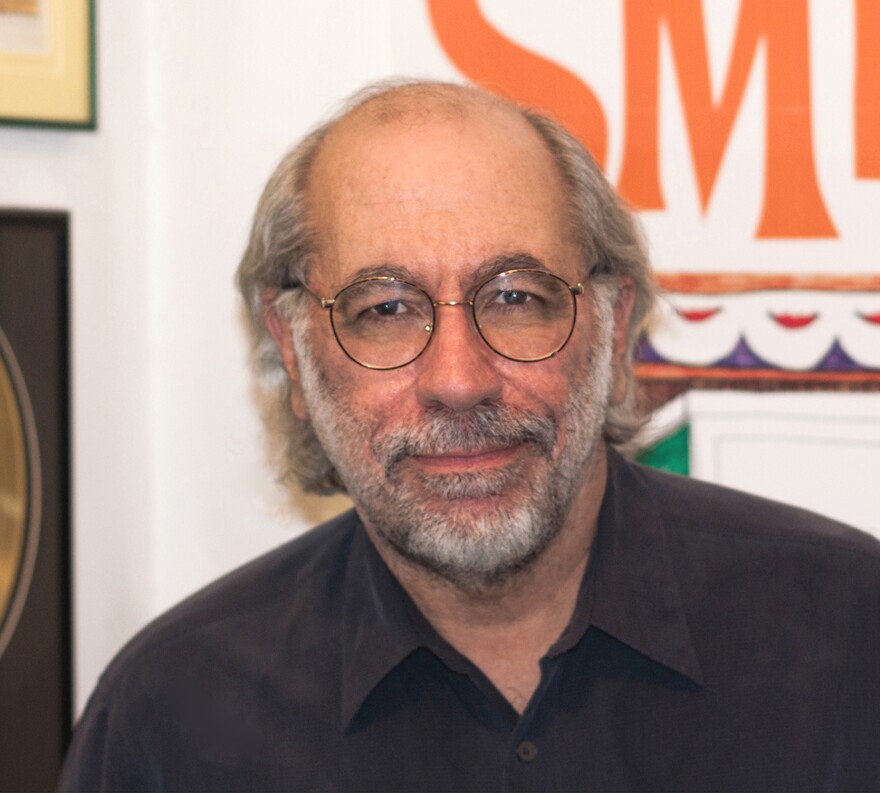For decades, stories have circulated about a Chicago gangster living in rural Norman, Okla. I’m Rachel Hopkin and although the bucolic landscape just a few miles from Lake Thunderbird seems a world away from the Windy City's violent underworld, in this How Curious episode, I investigate how the two are linked by a man whose life was split not only between the two places but, it seems, between two personalities.
I heard about this story from a friend of a friend. Actually, I heard about it from KGOU's Program Director, Jim Johnson, and he put me in touch put me with Larry Polk. Polk is a lifelong Oklahoma resident and told me that he remembers hearing rumors of the mafia in Brendle Corner – a property close to the intersection of State Highway 9 and 192nd Avenue – when he was in school in Norman back in the 1960s. “I always heard these things but I never could find anyone who knew anything about it. So one time I ran into this man and his name was Ernie Brendle." Brendle was working as a loss adjuster. “And I said ‘I hope it’s not offensive, but I have always heard about the mafia in Brendle Corner. Is it true?' And he said ‘Yes. He was my uncle – Murray The Camel Humphreys.'"
Humphreys went by many other names too – such as “The Hump” and “Curly”. But he was born Llewelyn Morris Humphreys in 1899. Gus Russo wrote extensively about him in The Outfit – his book about the powerful organized crime cartel of the same name. Russo told me that Humphreys was the son of dirt poor Welsh immigrants and was "turning into a juvenile delinquent. But he was also brilliant. Everyone who ever met him knew he was different, that he had a real brain."

Despite his illicit escapades, many found Humphreys both personable and exceptional. In 1913, during one of his many early arrests, he came before a judge who evidently saw potential in him. According to Russo, this man - Judge Murray - told the young offender "to read law books, maybe become a lawyer. For the rest of his life, he buried himself in all the big thick law textbooks, just looking for loopholes obviously. He loved it." Humphreys was so grateful for the judge’s advice that he changed his name to Murray in his honor.
Around a decade later, Humphreys evidently made a good impression on another man - the ruthless Al Capone - despite the unprepossessing circumstances in which the pair met. Larry Polk heard about this from Humphreys’ nephew, Ernie Brendle. Apparently, Humphreys had "hijacked a load of liquor that Capone owned and got caught. Usually that was a death sentence. So they brought him before Capone, and he was so likeable and so knowledgeable that Capone hired him on." Humphreys became an essential member of Capone’s Syndicate, and is rumored to have had some sort of a role in the St Valentine’s Day Massacre. But unlike some mobsters, Humphreys purposefully maintained a low profile.
The Capone meeting was an important turning point in the young man’s professional life. Gus Russo told me how it had been preceded by on in his personal life a few years earlier:
"In 1921, he was nabbed in a burglary (which he was doing many of) and he went on the run or “on the lam” as they call it. He was going to hide out with his brother, and his brother – for reasons I don’t know – had already settled down in Little Axe, Oklahoma. While he was there, he took a job as a Victrola salesman (people today probably have no what that is, but it’s like a record player). This is probably the only straight job Curly ever had. While going door to door as a salesman, he meets the woman who would become the love of his life, who was a native of Norman, half Cherokee. Her name was Clementine – Mary Clementine Brendle – or ‘Clemi.' She was a very pretty young girl and she was brilliant. According to legend, she had a photographic memory. They got married. And she was so bright that she became his accountant and she did it a lot just by memory."
And that’s saying something given the amounts of money she would end up managing.

After Capone was imprisoned for tax evasion in 1931, the young men who had been working for him emerged as the aforementioned Outfit. Humphreys became part of its “senior management” and was even its interim boss for a while in the 30s, despite having no Italian heritage. With the prohibition era now over, they needed new ways to make money. Humphreys is credited masterminding various strategies, among them union racketeering i.e. using union power to extort business bosses. Russo explained how this worked:
"Curly realized that they couldn’t control companies from the top, but they could control companies from the bottom, be it the truckers’ union, or the laundry union, or the milk union, or the linen union, whatever. First you’d have to take over the unions and that could be ugly. They would literally come in with machine guns into the union meetings and threaten people’s lives if they didn’t let them take it over. But once you had them, then the executives had to answer to you because you could strike whenever you want. It was crazy. What they were doing was is they were playing both sides against the middle. They would tell the workers 'we’re going to take care of you and make sure you get good wages and everything,' so the workers were cool with it. And then they’d go to the executives and say 'if you pay us, we’ll keep our demands very low and not ask for wages for our people, but we won’t tell them that.' So they were screwing both of them."
To give you some idea of the Outfit’s tactics, during the 16 months that they were targeting the laundries, over 150 shops were bombed. When they finally won, the laundry business became central to Humphrey’s plans. In fact, Larry Polk told me that this was how the expression laundering the money came about, as "what they were doing was taking the money from other things that were illegal and running them through the laundry business to ‘launder the money’."

Aside from presiding over the union racketeering and other money-making schemes, Russo said that Humphreys was also making good use of his legal knowledge.
"One of the things he studied and learned about was the fifth amendment, the right to not incriminate yourself in a court room, he realized you could also use it in front of congress. That had never been done before. In fact, when congressional hearings on organized crime would happen, the Chicago guys would plead the fifth and the committee members would say ‘you can’t do that’ and Curly would interrupt and say ‘yes, I think we can’, and he was always proven right."
Given the high pressure of his life in Chicago, it’s small wonder that Humphreys needed a place to escape to and he found it in rural Norman, OK, close to where Clemi had grown up. The couple and their daughter Luella lived in a handsome though unostentatious stone and brick house just across the way Brendle Corner. It’s now owned by retired Norman Fire Captain Jay Williams, who was kind enough to show me around. We were both very taken by the beautiful interior wood walls. When I asked Jay if he knew what the wood was, he said “No, but it has to be an expensive kind, just for it to sit there 100 years and not peel or warp or anything, it had to be high dollar." He went on to say that from what he’d heard, when Humphreys “was here, it was his family time. They would come here and relax and I don’t think there was any nefarious stuff that went on here."

Gus Russo is of the same mind: “Murray had, in my opinion, sort of a second life. It was like Clark Kent and Superman. He’d take his clothes off and become a Superman in Chicago and then go back to Norman and be a completely different person. Everybody loved him. A lot of people didn’t even know he was a gangster." That also chimes with what Larry Polk learned: “He was known for passing out silver dollars to people who were in need. He also gathered up turkeys at Thanksgiving and passed them out. He was really, really fond of the Native Americans out in the Brendle Corner area. Any time he hired one of them, he paid them really, really well."

One of the luxuries at the Humphreys property was a large swimming pool. It’s since been filled in but Jay showed me where it had been. Larry Polk remembered Ernie Brendle telling him a story about it being built: “It was a concrete swimming pool and when the cement was drying, Humphreys embedded silver dollars in it. And he used to get a huge kick watching people trying to go down there and get those silver dollars. No one could ever do it but they always tried." Those silver dollars were long gone by the time Jay bought the property, but during the decades that it belonged to Humphreys, the family spent a great deal of time here.
At some point, Humphreys and Clemi divorced and he married a much younger woman. Yet the two stayed friends and Humphreys continued to visit her at the house, including during the run up to the 1960 presidential race between Nixon and Kennedy. Polk recalled: "Ernie told me he was at the house when the day that the call came in from Chicago. They said ‘we’re backing JFK.' And he said usually he was fun and all of a sudden, he got really mad, and he was yelling 'No, no! We can’t do that. Joe Kennedy is a double crosser, we’ll get double crossed on this.' He went on and on and finally they said ‘well, the decision’s been made.' He said ‘OK’, and that’s what he did."
Humphreys returned to Chicago and went to work. But he was proved right. Joe Kennedy had promised The Outfit that if they supported his son, they’d be left in peace. However once the election was done, organized crime became the Department of Justice’s primary focus under the Kennedy administration.
Actually, Humphreys had been under surveillance by the FBI for decades, but had mostly managed to avoid getting into real trouble. In fact, he seems to have charmed its agents in the same way he charmed most other people he came across, at least according to another story passed to Polk by Ernie Brendle: "Humphreys was in Chicago and the driver said ‘the FBI is following us.' He said ‘okay. Stop at the next stop light. I’m going to go back and talk to them.' So he gets out of the car and goes back and he asks the guys ‘you guys FBI?’ Yes. ‘You following me?.' Yes. ‘Well, why don’t I get in with you and I’ll just sent my guy home.' Okay. That’s great. And he hopped in they took him everywhere they needed to go. They said he even bought them lunch."
However, by the mid 1960s, things had become a lot more serious. Humphreys was being pursued to appear before a grand jury in Chicago. He was arrested at the Norman railway station and taken back there. Once there and after his bail had been posted, Humphreys went to his apartment in the city. That's where he was on Thanksgiving Day of 1965, when more FBI agents turned up with a new arrest warrant. According to Polk, Humphreys “had a .38 in his hand, so they had to wrestle that away from him. And they got a key to his safe out of his pocket which greatly upset him. He had a heart condition anyway." Again, Humphreys made bail and returned to his flat. Later that evening, Polk said, his brother found him. "He had been vacuuming and had fallen over dead." Humphreys was 66 years old.

Humphreys' body was cremated and his ashes were taken back to the rural Oklahoma which he had so loved and where a mausoleum was built. It’s quite a way from the house and Jay doesn’t own the land it stands on as the original Humphreys’ property has since been parceled out into numerous different lots. It’s a substantial reddish marble block. Originally the only name engraved on it was Humphreys. Now it has Brendle Humphreys Brady – Brendle for Clemi, and Brady was the married name of their daughter Luella who died in 1992.

So an extraordinary and complex man, who, for all his likeability, could be merciless, as Gus Russo confirmed: "There certainly was a time in his life during the Capone years when he could have people killed. Either he killed them or he could have them killed. If there were union people who crossed the mob, Curly would have them killed. And it wasn’t often, it wasn’t like that was his stock in trade. He probably didn’t like doing it. But yeah, he was not a great guy."
My thanks to Gus Russo, Larry Polk, and Jay Williams for their participation in this episode. Thanks also to Kim and Gene Dick and Regina Howell.
How Curious is a production of KGOU Public Radio. It’s produced and hosted by Rachel Hopkin. The editor is Logan Layden and David Graey composed the theme music.
If you have an Oklahoma-related question or subject that you’d like How Curious to cover, please email us at curious@kgou.org.





